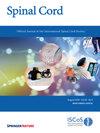Does the presence or absence of preoperative lower extremity neurologic symptoms influence postoperative clinical outcome in patients with cervical intradural extramedullary tumors?: a single-center retrospective comparative study
IF 2.2
4区 医学
Q3 CLINICAL NEUROLOGY
引用次数: 0
Abstract
Retrospective comparative study To investigate whether the presence or absence of preoperative lower extremities neurological symptoms (LENS) influences clinical outcomes following tumor resection in patients with cervical intradural extramedullary (IDEM) tumors. The single institution in Japan. Ninety-two patients with cervical IDEM tumors requiring surgical resection were included. Based on the degree of preoperative LENS assessed using the modified McCormick scale (MMCS), patients were categorized into LENS (–) and (+) groups. Demographic and surgical characteristics were compared between both groups. There were no significant differences observed in sex, tumor location, tumor size, surgical time, estimated blood loss, approach for tumorectomy, or tumor histopathology between the two groups. Additionally, the overall surgical outcomes were favorable for both groups. At the final follow-up, 91.1% of the patients in the LENS (+) group were able to walk without support. Improvement in LENS was observed after surgery in most patients with preoperative MMCS II–IV, but it persisted in approximately 40% of patients with preoperative MMCS V. In the LENS (+) group, there were no significant differences in demographic or surgical data between the patients with MMCS I and II–III at the final follow-up. Regardless of the presence or absence of preoperative LENS, clinical improvement was observed after tumor resection in most patients with cervical IDEM tumors. These findings suggest that neurological status is likely to improve sufficiently if tumor resection is performed before preoperative LENS deteriorates to an extremely severe stage as MMCS V.颈椎硬膜外肿瘤患者术前有无下肢神经症状会影响术后临床预后吗:一项单中心回顾性比较研究。
研究设计:回顾性比较研究 目的研究颈椎硬膜外肿瘤(IDEM)患者术前是否出现下肢神经症状(LENS)是否会影响肿瘤切除术后的临床预后:方法方法:纳入92例需要手术切除的颈椎IDEM肿瘤患者。根据使用改良麦考密克量表(MMCS)评估的术前LENS程度,将患者分为LENS(-)组和(+)组。对两组患者的人口统计学特征和手术特征进行比较:结果:两组患者在性别、肿瘤位置、肿瘤大小、手术时间、估计失血量、肿瘤切除方式或肿瘤组织病理学方面均无明显差异。此外,两组患者的总体手术效果良好。在最后的随访中,LENS(+)组有91.1%的患者能够在没有支撑的情况下行走。在 LENS(+)组中,MMCS I 和 II-III 患者的人口统计学和手术数据在最终随访时没有显著差异:结论:无论术前是否存在LENS,大多数颈部IDEM肿瘤患者在肿瘤切除后临床症状都有所改善。这些研究结果表明,如果在术前 LENS 恶化到 MMCS V 的极其严重阶段之前进行肿瘤切除,神经状况很可能会得到充分改善。
本文章由计算机程序翻译,如有差异,请以英文原文为准。
求助全文
约1分钟内获得全文
求助全文
来源期刊

Spinal cord
医学-临床神经学
CiteScore
4.50
自引率
9.10%
发文量
142
审稿时长
2 months
期刊介绍:
Spinal Cord is a specialised, international journal that has been publishing spinal cord related manuscripts since 1963. It appears monthly, online and in print, and accepts contributions on spinal cord anatomy, physiology, management of injury and disease, and the quality of life and life circumstances of people with a spinal cord injury. Spinal Cord is multi-disciplinary and publishes contributions across the entire spectrum of research ranging from basic science to applied clinical research. It focuses on high quality original research, systematic reviews and narrative reviews.
Spinal Cord''s sister journal Spinal Cord Series and Cases: Clinical Management in Spinal Cord Disorders publishes high quality case reports, small case series, pilot and retrospective studies perspectives, Pulse survey articles, Point-couterpoint articles, correspondences and book reviews. It specialises in material that addresses all aspects of life for persons with spinal cord injuries or disorders. For more information, please see the aims and scope of Spinal Cord Series and Cases.
 求助内容:
求助内容: 应助结果提醒方式:
应助结果提醒方式:


